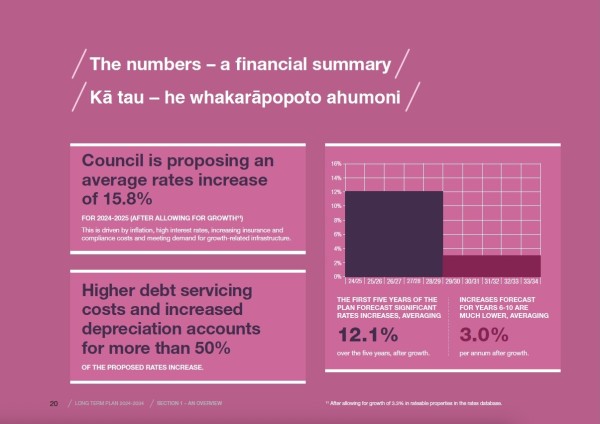Shaping our Community News Blog
Understanding rates increases and what’s coming next
In recent years, residents in the Queenstown Lakes District have weathered successive rate hikes—measures that, although difficult, reflect an unavoidable yet strategic need to future-proof essential services and sustainable growth.
In 2024, we delivered the QLDC Long Term Plan, which was informed by extensive public and council consultation. This document laid out a proposed average rates rise of 15.6% for the 2024–25 financial year. While high, it was essential to balance the budget.
By June 2025, the Council faced another steep adjustment. QLDC’s Annual Plan 2025–26, adopted on 26 June 2025, approved an average rates increase of 13.5% for that year. We know that this differed across the district, with Wānaka and Luggate seeing an 18.7% and 17.6% (respectively) median rates increase and Arrowtown residents seeing around 10%.
While the latest increase is slightly less than the previous year’s, both remain significant and add to the ongoing financial challenges for ratepayers.
The graph below shows the 10-year forecast for rates. Over the next three years, further increases are projected before moderation sets in.

While this is far from ideal, it is my view that we must address these challenges now, rather than deferring difficult decisions. Acting decisively today not only helps prevent even greater costs in the future, but also positions us to benefit from a broader ratepayer base as our district grows. In other words, although we may see higher rates hikes in the immediate term, healthy growth provides a pathway to greater financial resilience for everyone in the long run.
Why are rates rising so rapidly?
The reality of rising rates is anchored in the substantial costs of keeping our district running and growing, and periods of underinvestment. These increases are not simply the result of administrative decisions or unexpected expenses—they’re shaped by fundamental pressures that include population growth, inflation, and the urgent need to renew or expand infrastructure.
Rates are being directed towards the essentials: improving water supplies, maintaining roads, servicing debts from past investments, and upholding the quality of community facilities. There is no surplus; instead, the focus is on safeguarding long-term resilience and ensuring our communities continue to thrive.
We have had to fund major capital works, including the Upper Clutha wastewater conveyance scheme expansion (Project Pure), with a total budget of $80 M, serving Wānaka, Hāwea, and Albert Town. However, we changed our procurement strategy, making it easier for smaller firms to tender for the work. This has led to substantial savings in both future costs and delivery time.
And most significantly, our rates must cover depreciation and finance costs.
A key factor of rates increases: Depreciation and Finance Costs
Over the past decade, our funding for depreciation has steadily declined. Most assets lose their value over time due to wear and tear, and depreciation is used to recognise this decrease in value and spread the cost over their useful life. This underfunding means we’re not keeping pace with what’s needed to look after water supply schemes, stormwater systems, roads, community facilities, and other essential assets. If we don’t reverse this trend now, we face a future where failing infrastructure becomes the norm. Paying it forward today helps ensure we’re not handing a bigger, more expensive problem to the next generation of ratepayers.
Let’s not forget the cost of finance. The Council has had to borrow to settle legacy liabilities, like expensive leaky building claims. The interest and principal repayments on these loans also contribute to the rates you’re seeing now.
For context, salaries and wages account for just over 18% of our expenditure, one of the lowest percentages among comparable councils, so the real pressure comes from the need to fund our infrastructure for years to come responsibly.
We need to get the basics done first
I know that residents are feeling the impact of rates increases in their daily lives, and it’s understandable to have concerns about the road ahead. Yet, by choosing to address these challenges now, we’re investing in a stronger, more resilient district for ourselves and for future generations. Ultimately, the Council’s strategy aims to invest in the district’s future today, accepting short-term discomfort to secure the ongoing viability and prosperity of Queenstown Lakes over the coming years. We need to get the basics done first, and we need to do it right.
Want to know more about why costs are on the rise for all local government authorities? I encourage you to read Infometrics’ analysis of cost pressures on local government.

